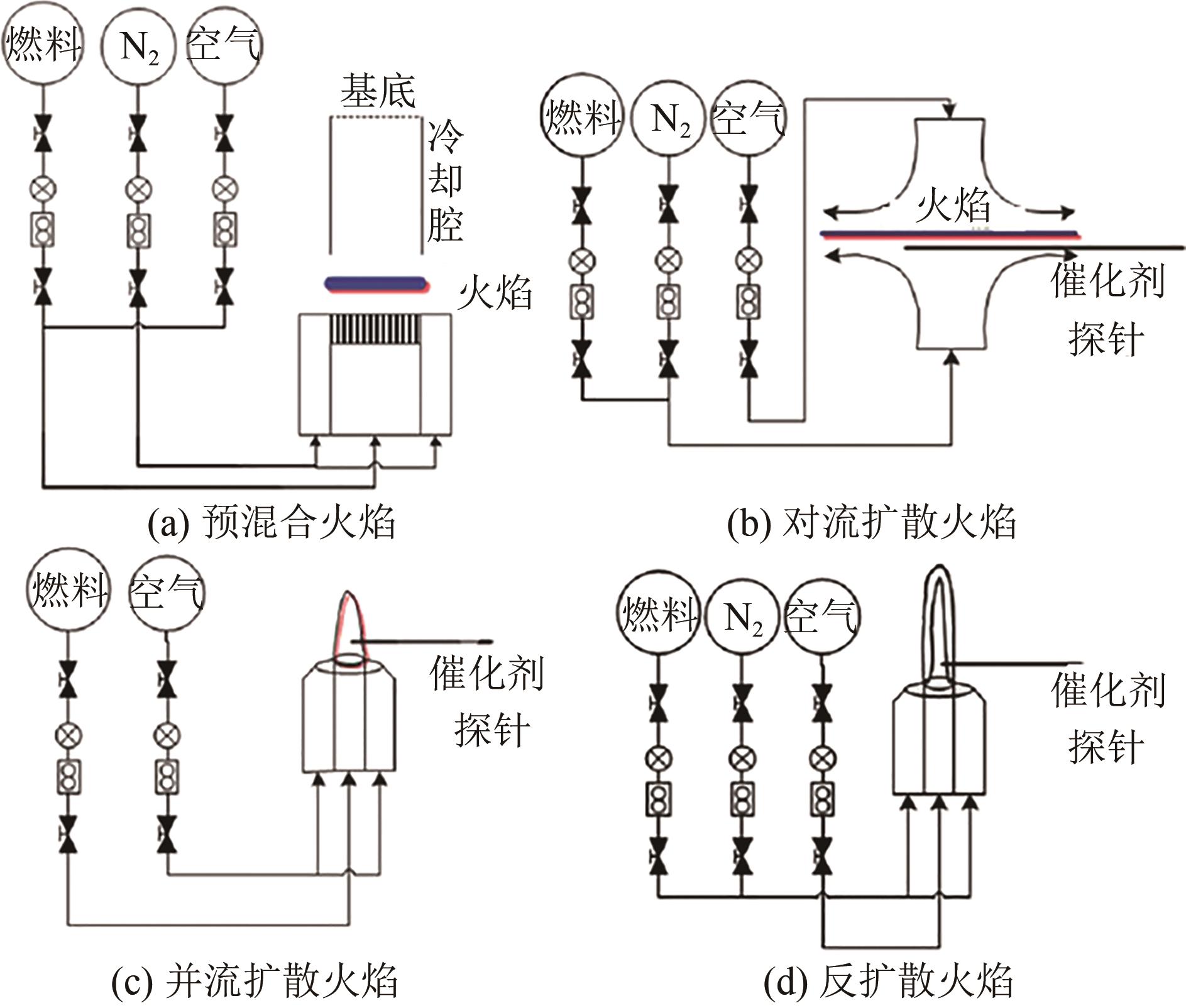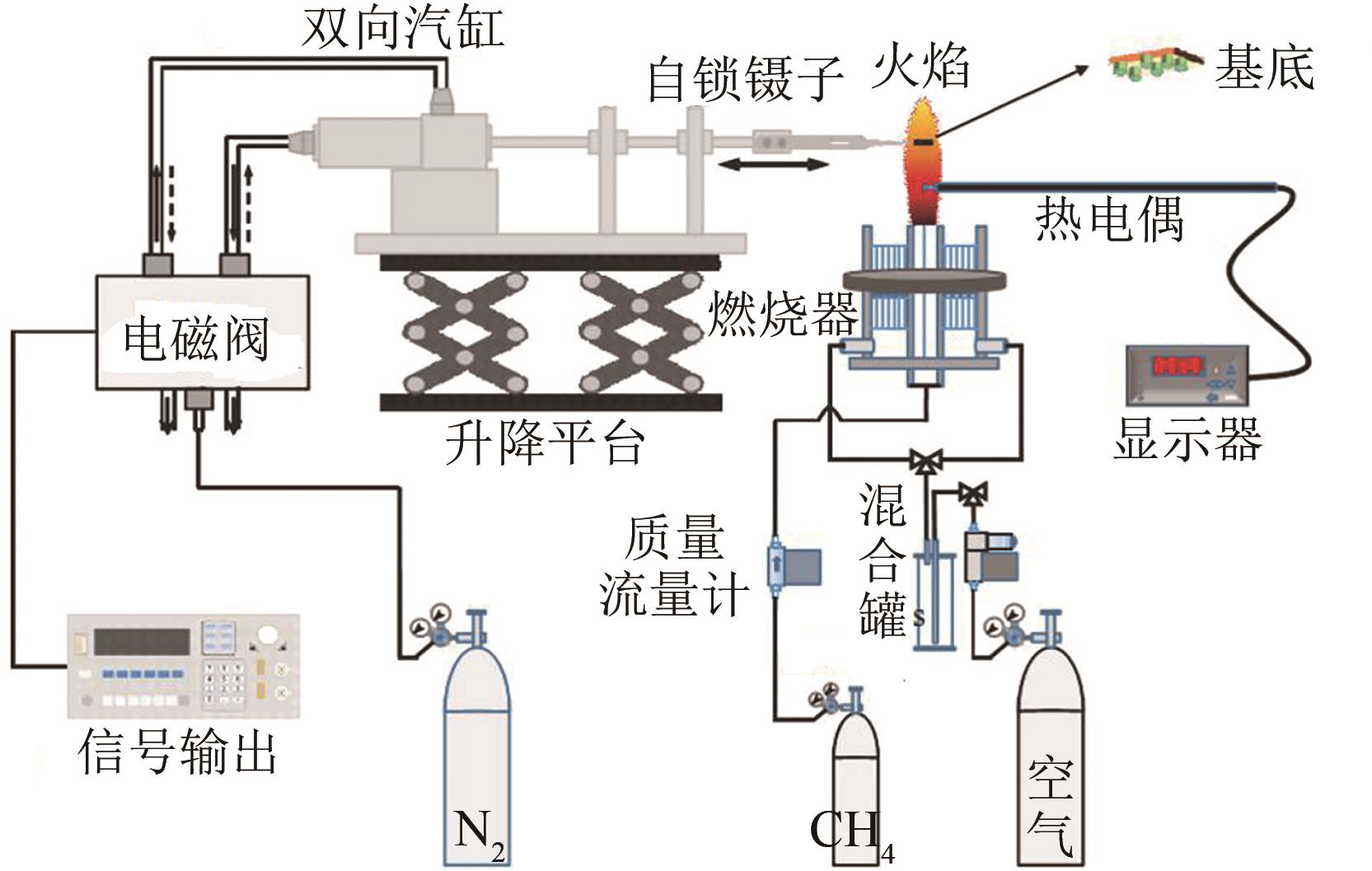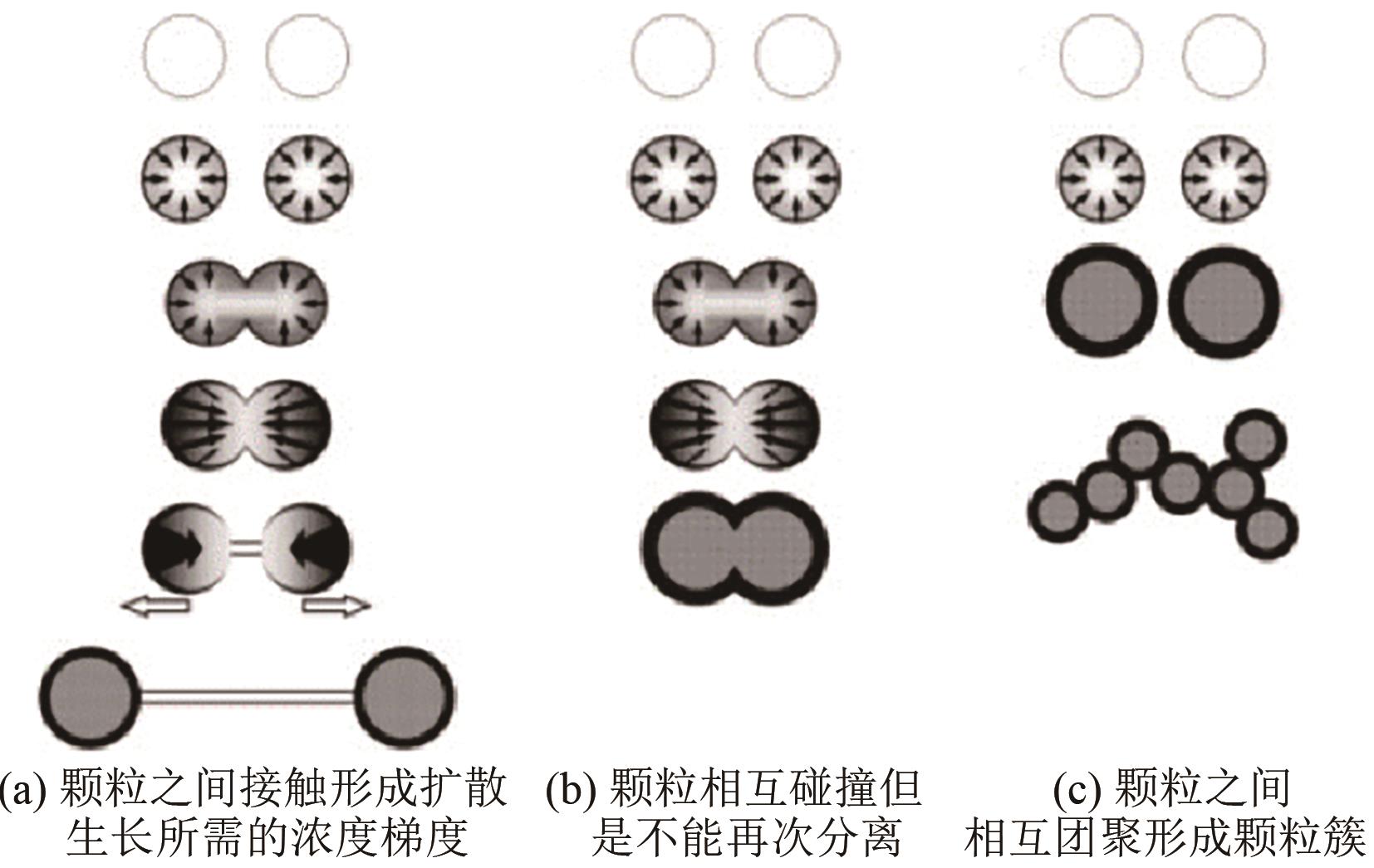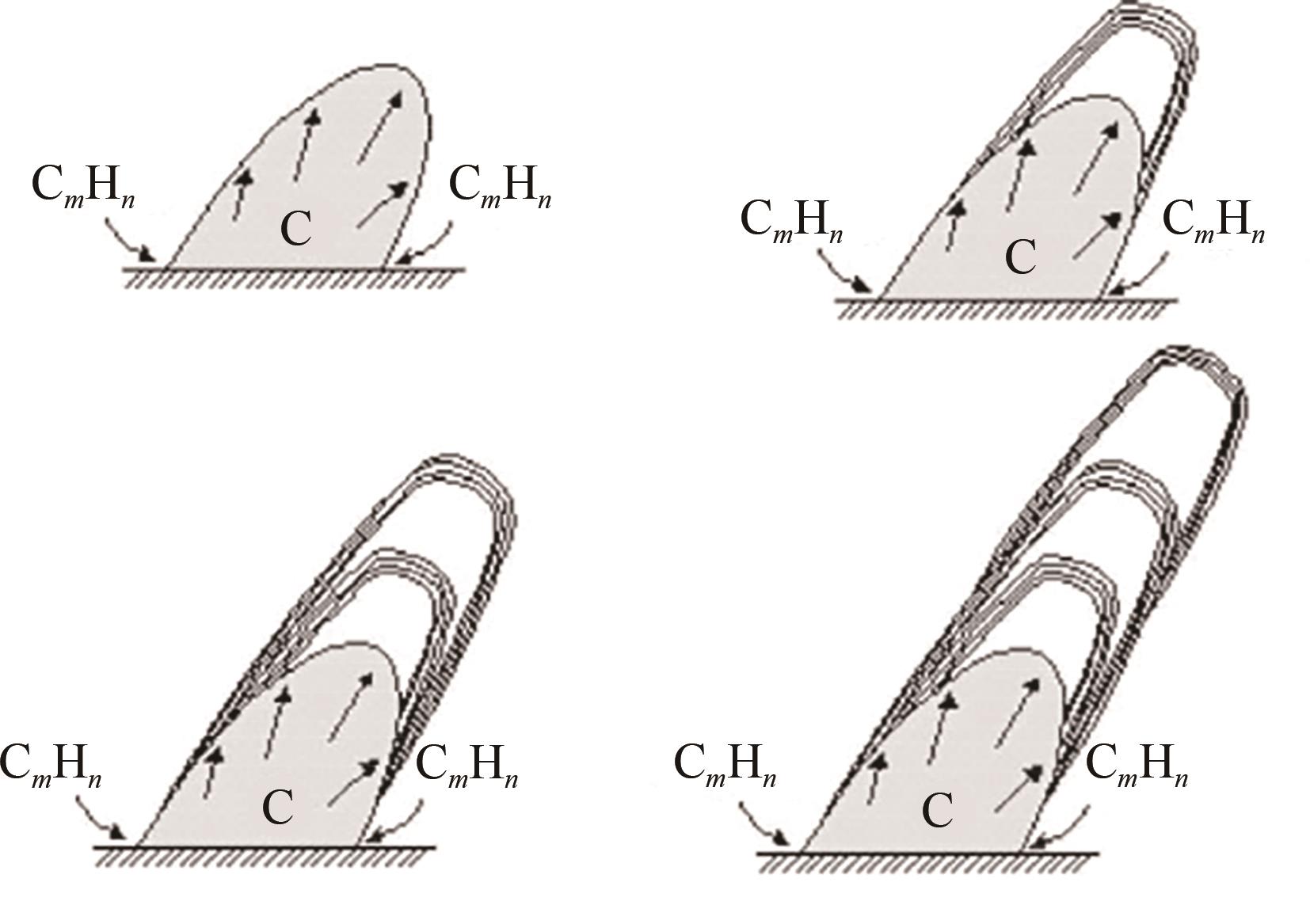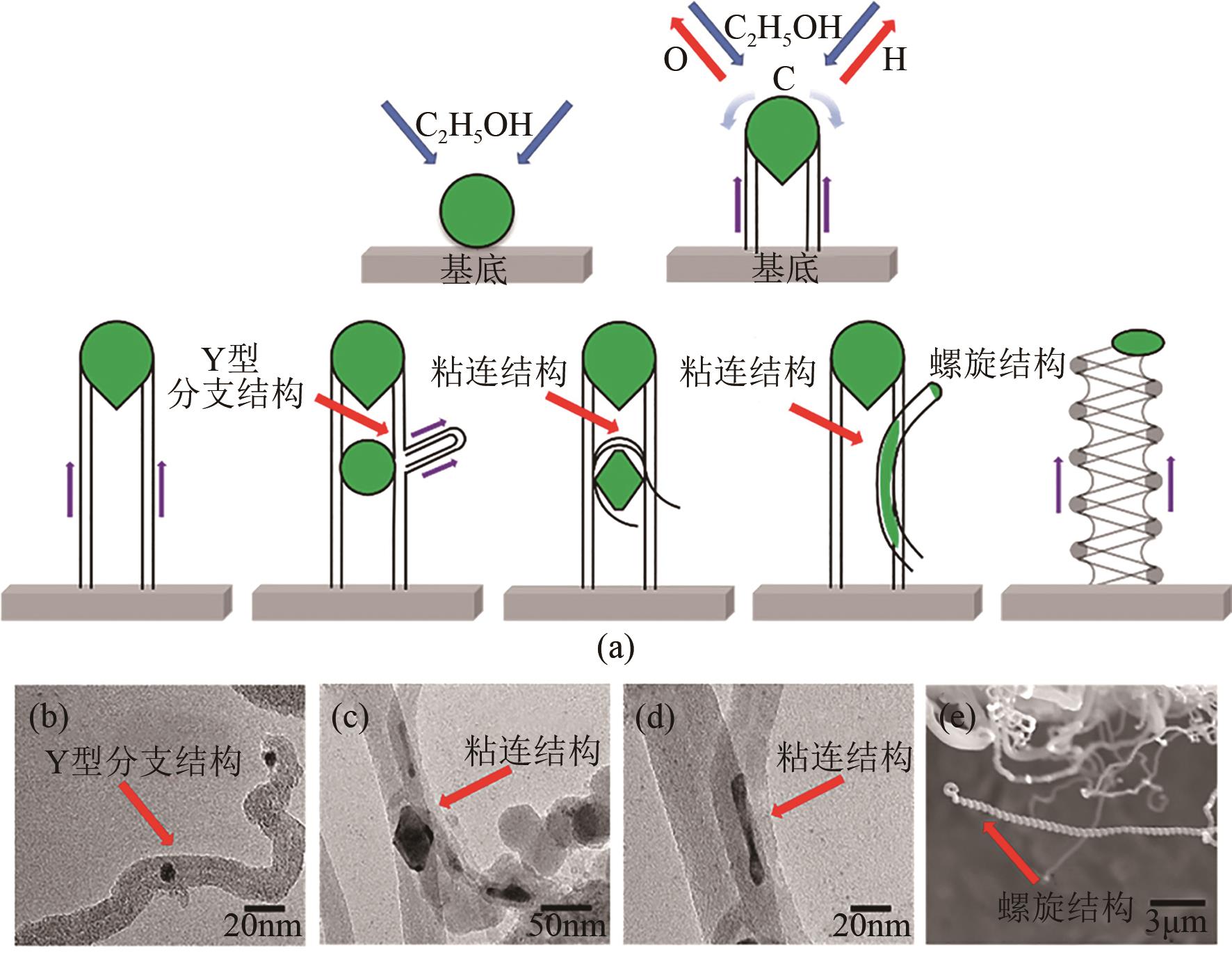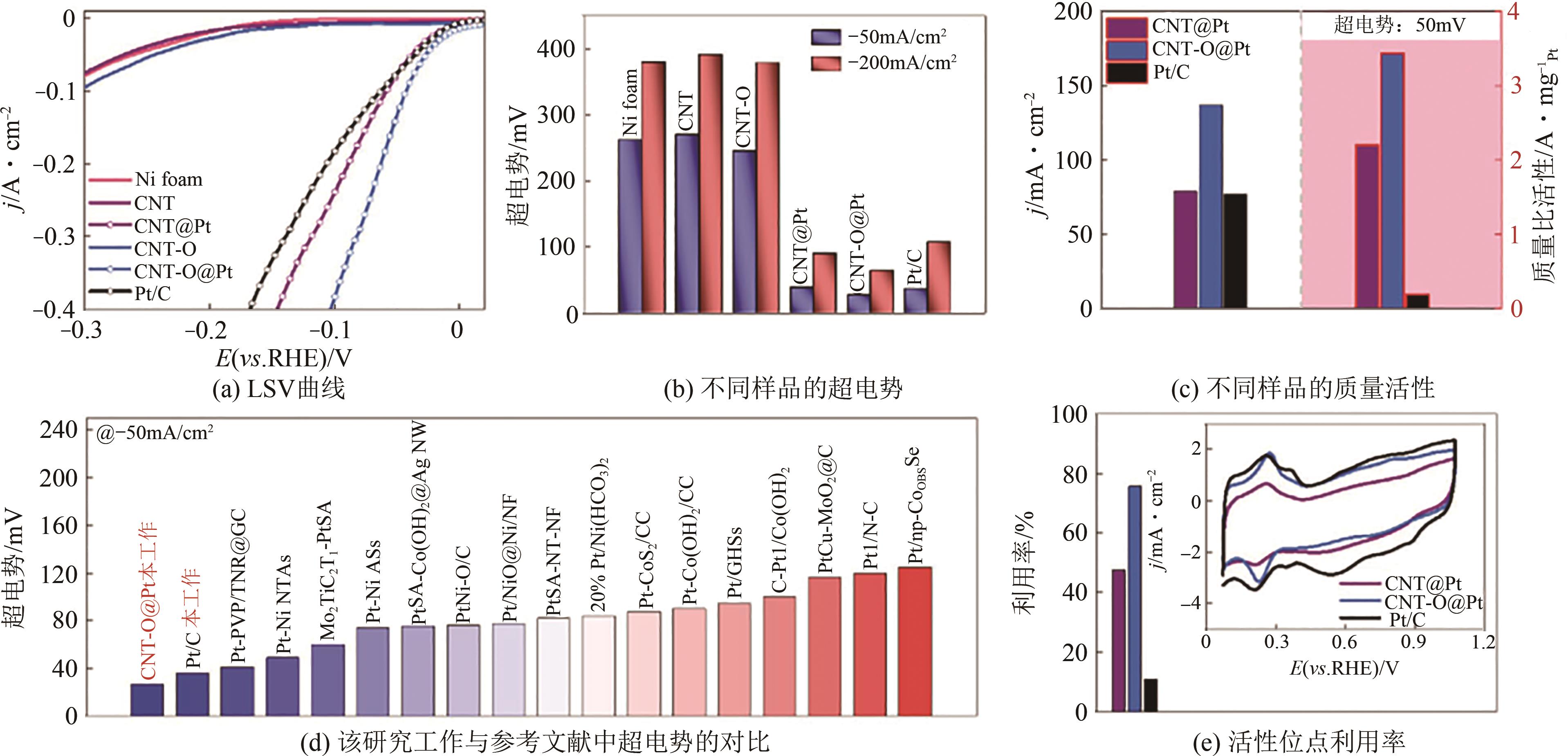化工进展 ›› 2023, Vol. 42 ›› Issue (12): 6409-6418.DOI: 10.16085/j.issn.1000-6613.2023-0162
• 材料科学与技术 • 上一篇
火焰法制备CNTs基复合材料及其应用研究进展
张帅国1( ), 马文媛1, 赵海鹏1, 冯宇2(
), 马文媛1, 赵海鹏1, 冯宇2( ), 蔡旭萍1, 杨士祥1, 钱新月1, 米杰2
), 蔡旭萍1, 杨士祥1, 钱新月1, 米杰2
- 1.河南城建学院材料与化工学院,河南 平顶山 467000
2.太原理工大学省部共建煤基能源清洁高效利用 国家重点实验室,山西 太原 030002
-
收稿日期:2023-02-08修回日期:2023-03-26出版日期:2023-12-25发布日期:2024-01-08 -
通讯作者:张帅国,冯宇 -
作者简介:张帅国(1989—),男,博士,讲师,研究方向为碳纳米材料、锂/钠离子电池电极材料。E-mail:zhangguoyuan.1234@163.com。 -
基金资助:河南省科技攻关计划(232102231031);河南省高校大学生创新创业训练计划(202211765029)
Progress of flame synthesis of carbon nanotubes based composites and their practical applications
ZHANG Shuaiguo1( ), MA Wenyuan1, ZHAO Haipeng1, FENG Yu2(
), MA Wenyuan1, ZHAO Haipeng1, FENG Yu2( ), CAI Xuping1, YANG Shixiang1, QIAN Xinyue1, MI Jie2
), CAI Xuping1, YANG Shixiang1, QIAN Xinyue1, MI Jie2
- 1.College of Material and Chemical Engineering, Henan University of Urban Construction, Pingdingshan 467000, Henan, China
2.Key Laboratory of Coal Science and Technology of Ministry of Education and Shanxi Province, Taiyuan University of Technology, Taiyuan 030002, Shanxi, China
-
Received:2023-02-08Revised:2023-03-26Online:2023-12-25Published:2024-01-08 -
Contact:ZHANG Shuaiguo, FENG Yu
摘要:
火焰法制备CNTs及其复合材料具有可连续操作、成本低廉等优势,是一种极具应用潜力的制备技术。然而,火焰环境的复杂性造成产品结构和组成难以精确控制,在实际应用时不利于产品性能的调控和提升。本文首先介绍了火焰法的基本构型(扩散火焰和预混合火焰),并结合燃料、催化剂和制备CNTs的结构说明了不同火焰法工艺的特点。随后简要说明了火焰环境中CNTs生长的一般过程,即吸附-扩散-沉积过程,结合这一基本过程介绍了顶部/底部生长机理、颗粒接触生长机理和异形(螺旋状、竹节状、空心/实心结构、分支结构等)CNTs的生长机理。在全面总结火焰法制备CNTs基复合材料在储能、催化、光热转化等领域应用的基础上,指出现有火焰法制备工艺存在可控性差、产品组成复杂等问题,在实际应用时不利于相关性能的调控。在未来研究中,持续改进和优化火焰法工艺,如采用混合式制备工艺或构建分段式燃烧器构型,对于提高工艺过程可控性并实现产品组成和结构的调控具有积极作用。
中图分类号:
引用本文
张帅国, 马文媛, 赵海鹏, 冯宇, 蔡旭萍, 杨士祥, 钱新月, 米杰. 火焰法制备CNTs基复合材料及其应用研究进展[J]. 化工进展, 2023, 42(12): 6409-6418.
ZHANG Shuaiguo, MA Wenyuan, ZHAO Haipeng, FENG Yu, CAI Xuping, YANG Shixiang, QIAN Xinyue, MI Jie. Progress of flame synthesis of carbon nanotubes based composites and their practical applications[J]. Chemical Industry and Engineering Progress, 2023, 42(12): 6409-6418.
| 火焰构型 | 燃料/氧化剂 | 催化剂/基底 | 结构/组成 | 应用 | 参考文献 |
|---|---|---|---|---|---|
| 扩散火焰 | 乙醇/空气 | NiSO4·6H2O/钛箔 | 螺旋碳纳米纤维/CuO/NiO | 超级电容器电极 | [ |
| 扩散火焰 | 乙醇/空气 | 304不锈钢 | CNFs/Fe2O3 | 超级电容器电极 | [ |
| 预混合火焰 | 乙醇/氧气 | 二茂铁 | C@Fe2O3/SWCNT | 锂离子电池负极 | [ |
| 扩散火焰 | 乙醇/空气 | Fe(acac)3/碳布 | M-FeO-CNT | 超级电容器电极 | [ |
| 扩散火焰 | 乙醇/空气 | Ni(NO3)2/304不锈钢 | CNTs | 钠离子电池负极 | [ |
| 扩散火焰 | 乙醇/空气 | Ni(NO3)2/硫脲/镍箔 | CNTs | 染料敏化太阳能电池电极 | [ |
| 扩散火焰 | 乙醇/空气 | NiCl2/CNTs | CNTs | 锂离子电池负极 | [ |
| 扩散火焰 | 乙醇/丙酮/空气 | 玻璃 | 碳微球 | 电催化(ORR) | [ |
| 扩散火焰 | 乙醇/空气 | 泡沫镍 | CNT-O@M(M=Co和Pt) | 电催化(ORR和HER) | [ |
| 扩散火焰 | 乙醇/空气 | 二茂铁/玻璃 | MWCNTs-Fe2O3 | 电化学传感器 | [ |
| 扩散火焰 | 乙醇/空气 | NiCl2/碳纤维 | CNTs | 热电功能材料 | [ |
| 扩散火焰 | 乙醇/空气 | Fe(acac)3/泡沫镍 | Fe2O3/CNT/NF | 光-热功能材料 | [ |
| 扩散火焰 | 乙醇/空气 | NiCl2/玻璃纤维 | CNTs | 结构材料 | [ |
| 扩散火焰 | 乙醇/空气 | 泡沫镍 | CNTs-NF | 钠离子电池负极 | [ |
表1 火焰法制备CNTs基复合材料的方法和应用
| 火焰构型 | 燃料/氧化剂 | 催化剂/基底 | 结构/组成 | 应用 | 参考文献 |
|---|---|---|---|---|---|
| 扩散火焰 | 乙醇/空气 | NiSO4·6H2O/钛箔 | 螺旋碳纳米纤维/CuO/NiO | 超级电容器电极 | [ |
| 扩散火焰 | 乙醇/空气 | 304不锈钢 | CNFs/Fe2O3 | 超级电容器电极 | [ |
| 预混合火焰 | 乙醇/氧气 | 二茂铁 | C@Fe2O3/SWCNT | 锂离子电池负极 | [ |
| 扩散火焰 | 乙醇/空气 | Fe(acac)3/碳布 | M-FeO-CNT | 超级电容器电极 | [ |
| 扩散火焰 | 乙醇/空气 | Ni(NO3)2/304不锈钢 | CNTs | 钠离子电池负极 | [ |
| 扩散火焰 | 乙醇/空气 | Ni(NO3)2/硫脲/镍箔 | CNTs | 染料敏化太阳能电池电极 | [ |
| 扩散火焰 | 乙醇/空气 | NiCl2/CNTs | CNTs | 锂离子电池负极 | [ |
| 扩散火焰 | 乙醇/丙酮/空气 | 玻璃 | 碳微球 | 电催化(ORR) | [ |
| 扩散火焰 | 乙醇/空气 | 泡沫镍 | CNT-O@M(M=Co和Pt) | 电催化(ORR和HER) | [ |
| 扩散火焰 | 乙醇/空气 | 二茂铁/玻璃 | MWCNTs-Fe2O3 | 电化学传感器 | [ |
| 扩散火焰 | 乙醇/空气 | NiCl2/碳纤维 | CNTs | 热电功能材料 | [ |
| 扩散火焰 | 乙醇/空气 | Fe(acac)3/泡沫镍 | Fe2O3/CNT/NF | 光-热功能材料 | [ |
| 扩散火焰 | 乙醇/空气 | NiCl2/玻璃纤维 | CNTs | 结构材料 | [ |
| 扩散火焰 | 乙醇/空气 | 泡沫镍 | CNTs-NF | 钠离子电池负极 | [ |
| 1 | SANCHEZ-VALENCIA J R, DIENEL T, GRÖNING O, et al. Controlled synthesis of single-chirality carbon nanotubes[J]. Nature, 2014, 512(7512): 61-64. |
| 2 | CASAS C, LI W Z. A review of application of carbon nanotubes for lithium ion battery anode material[J]. Journal of Power Sources, 2012, 208: 74-85. |
| 3 | MISHRA Vijay, SINGH Manvendra, NAYAK Pallavi, et al. Carbon nanotubes as emerging nanocarriers in drug delivery: An overview[J]. International Journal of Pharmaceutical Quality Assurance, 2020, 11(3): 373-378. |
| 4 | HAMZAH N, MOHD Y M F, MOHD Y M Z, et al. Rapid production of carbon nanotubes: A review on advancement in growth control and morphology manipulations of flame synthesis[J]. Journal of Materials Chemistry A, 2017, 5(48): 25144-25170. |
| 5 | MITTAL G, DHAND V, RHEE K Y, et al. Carbon nanotubes synthesis using diffusion and premixed flame methods: A review[J]. Carbon Letters, 2015, 16(1): 1-10. |
| 6 | IIJIMA Sumio. Helical microtubules of graphitic carbon[J]. Nature, 1991, 354(6348): 56-58. |
| 7 | CHONG C T, TAN W H, LEE S L, et al. Morphology and growth of carbon nanotubes catalytically synthesised by premixed hydrocarbon-rich flames[J]. Materials Chemistry and Physics, 2017, 197: 246-255. |
| 8 | SAITO K, GORDON A S, WILLIAMS F A, et al. A study of the early history of soot formation in various hydrocarbon diffusion flames[J]. Combustion Science and Technology, 1991, 80(1/2/3): 103-119. |
| 9 | 韩伟伟, 汪鹏, 卫言, 等. 火焰法制备碳纳米管研究进展[J]. 过程工程学报, 2019, 19(1): 3-13. |
| HAN Weiwei, WANG Peng, WEI Yan, et al. Progress in flame synthesis of carbon nanotubes[J]. The Chinese Journal of Process Engineering, 2019, 19(1): 3-13. | |
| 10 | MERCHAN-MERCHAN W, SAVELIEV A V, KENNEDY L, et al. Combustion synthesis of carbon nanotubes and related nanostructures[J]. Progress in Energy and Combustion Science, 2010, 36(6): 696-727. |
| 11 | HAN Weiwei, CHU Huaqiang, Yuchen YA, et al. Effect of fuel structure on synthesis of carbon nanotubes in diffusion flames[J]. Fullerenes, Nanotubes and Carbon Nanostructures, 2019, 27(3): 265-272. |
| 12 | HU W C, LIN T. Ethanol flame synthesis of carbon nanotubes in deficient oxygen environments[J]. Nanotechnology, 2016, 27(16): 165602. |
| 13 | YUAN Liming, LI Tianxiang, SAITO Kozo. Growth mechanism of carbon nanotubes in methane diffusion flames[J]. Carbon, 2003, 41(10): 1889-1896. |
| 14 | YUAN Liming, SAITO Kozo, HU Wenchong, et al. Ethylene flame synthesis of well-aligned multi-walled carbon nanotubes[J]. Chemical Physics Letters, 2001, 346(1/2): 23-28. |
| 15 | CHU Huaqiang, HAN Weiwei, REN Fei, et al. Flame synthesis of carbon nanotubes on different substrates in methane diffusion flames[J]. ES Energy & Environment, 2018, 2: 73-81. |
| 16 | VANDER W R, TICICH T M, CURTIS V E. Diffusion flame synthesis of single-walled carbon nanotubes[J]. Chemical Physics Letters, 2000, 323(3/4): 217-223. |
| 17 | LEE G W, JURNG J, HWANG J. Formation of Ni-catalyzed multiwalled carbon nanotubes and nanofibers on a substrate using an ethylene inverse diffusion flame[J]. Combustion and Flame, 2004, 139(1/2): 167-175. |
| 18 | WU Jianpeng, LIANG Kaiheng, YANG Chaoqiang, et al. Synthesis of carbon nanotubes on metal mesh in inverse diffusion biofuel flames[J]. Fullerenes, Nanotubes and Carbon Nanostructures, 2019, 27(1): 77-86. |
| 19 | GUO Yonghong, ZHAI Gang, RU Yu, et al. Effect of different catalyst preparation methods on the synthesis of carbon nanotubes with the flame pyrolysis method[J]. AIP Advances, 2018, 8(3): 035111. |
| 20 | GUO Yonghong, WU Chuyu, WANG Tao, et al. The effect of pyrolysis temperature on the synthesis of carbon nanotubes by a flame method[J]. Materials Research Express, 2019, 6: 105007 |
| 21 | MERCHAN-MERCHAN W, SAVELIEV A V, KENNEDY L A. Flame nanotube synthesis in moderate electric fields: From alignment and growth rate effects to structural variations and branching phenomena[J]. Carbon, 2006, 44(15): 3308-3314. |
| 22 | HU W C, HOU S S, LIN T. Analysis on controlling factors for the synthesis of carbon nanotubes and nano-onions in counterflow diffusion flames[J]. Journal of Nanoscience and Nanotechnology, 2014, 14(7): 5363-5369. |
| 23 | HU W C, SARI S, HOU S, et al. Effects of acoustic modulation and mixed fuel on flame synthesis of carbon nanomaterials in an atmospheric environment[J]. Materials (Basel, Switzerland), 2016, 9(11): 939. |
| 24 | HEIGHT M J, HOWARD J B, TESTER J W, et al. Flame synthesis of single-walled carbon nanotubes[J]. Carbon, 2004, 42(11): 2295-2307. |
| 25 | VANDER W R L, BERGER G M, TICICH T M. Carbon nanotube synthesis in a flame using laser ablation for in situ catalyst generation[J]. Applied Physics A, 2003, 77(7): 885-889. |
| 26 | LI Hao, HE Delong, LI Tiehu, et al. Chemical kinetics of catalytic chemical vapor deposition of an acetylene/xylene mixture for improved carbon nanotube production[J]. Carbon, 2010, 48(15): 4330-4342. |
| 27 | WEN J Z, RICHTER H, GREEN W H, et al. Experimental study of catalystnanoparticle and single walled carbon nanotube formation in a controlled premixed combustion[J]. Journal of Materials Chemistry, 2008, 18(13): 1561-1569. |
| 28 | OKADA Shohei, SUGIME Hisashi, HASEGAWA Kei, et al. Flame-assisted chemical vapor deposition for continuous gas-phase synthesis of 1-nm-diameter single-wall carbon nanotubes[J]. Carbon, 2018, 138: 1-7. |
| 29 | ZHANG C, TIAN B, CHONG C T, et al. Synthesis of single-walled carbon nanotubes in rich hydrogen/air flames[J]. Materials Chemistry and Physics, 2020, 254: 123479. |
| 30 | IBRAHIM M H, HAMZAH N, MOHD Y M, et al. The control on morphology and crystallinity of CNT in flame synthesis with one-dimensional reaction zone[J]. Beilstein Journal of Nanotechnology, 2023, 14: 741-750. |
| 31 | BAKER R T K. Catalytic growth of carbon filaments[J]. Carbon, 1989, 27(3): 315-323. |
| 32 | LIM X X, LOW S C, OH W D. A critical review of heterogeneous catalyst design for carbon nanotubes synthesis: Functionalities, performances, and prospects[J]. Fuel Processing Technology, 2023, 241: 107624. |
| 33 | HEIGHT M J, HOWARD J B, TESTER J W, et al. Carbon nanotube formation and growth via particle-particle interaction[J]. The Journal of Physical Chemistry B, 2005, 109(25): 12337-12346. |
| 34 | XIONG Xuhai, ZHAO Pu, REN Rong, et al. Flame-synthesis of carbon nanotube forests on metal mesh structure: Dependence, morphology, and application[J]. Nanomaterials, 2019, 9(9): 1188. |
| 35 | ZENG Wei, XIE Yuqiao, SUN Liangwu, et al. Flame synthesis of spring-like nanocarbon and its application in flexible free-standing mattress-like supercapacitor electrode[J]. Journal of the Electrochemical Society, 2017, 164(12): A2823-A2829. |
| 36 | MO Youtian, MENG Wei, XIA Yanlin, et al. Facile flame deposit of CNFs/Fe2O3 coating on 304 stainless steel mesh and their high capacitive performance[J]. Electrochimica Acta, 2020, 335: 135527. |
| 37 | WANG Wenyu, FENG Yu, ZHANG Shuaiguo, et al. Facile premixed flame synthesis C@Fe2O3/SWCNT as superior free-standing anode for lithium-ion batteries[J]. Journal of Alloys and Compounds, 2022, 905: 164247. |
| 38 | WANG Yuan, ZHANG Tao, XIAO Jianfei, et al. Enhancing electrochemical performance of ultrasmall Fe2O3-embedded carbon nanotubes via combusting-induced high-valence dopants[J]. Journal of Materials Science & Technology, 2023, 134: 142-150. |
| 39 | HAN Weiwei, ZHOU Yong, ZHU Ting, et al. Combustion synthesis of defect-rich carbon nanotubes as anodes for sodium-ion batteries[J]. Applied Surface Science, 2020, 520: 146317. |
| 40 | ZHENG Li, BAO Chao, LEI Shengjun, et al. In situ growing CNTs encapsulating nickel compounds on Ni foils with ethanol flame method as superior counter electrodes of dye-sensitized solar cells[J]. Carbon, 2018, 133: 423-434. |
| 41 | 李珊珊, 薛浪浪, 王文雨, 等. 火焰法合成氧化铁/氮掺杂单壁碳纳米管及其电化学性能研究[J]. 天然气化工(C1化学与化工), 2021, 46(2): 47-52. |
| LI Shanshan, XUE Langlang, WANG Wenyu, et al. Synthesis of iron oxide/nitrogen doped single-walled carbon nanotubes by flame method and study on its electrochemical performance[J].Natural Gas Chemical Industry, 2021, 46(2): 47-52. | |
| 42 | MO Youtian, ZHOU Helezi, ZHANG Biao, et al. Facile flame catalytic growth of carbon nanomaterials on the surface of carbon nanotubes[J]. Applied Surface Science, 2019, 465: 23-30. |
| 43 | WANG Wei, WANG Pengde, KANG Yumao, et al. Flame synthesis of nitrogen, boron co-doped carbon as efficient electrocatalyst for oxygen reduction reaction[J]. International Journal of Hydrogen Energy, 2019, 44(10): 4771-4779. |
| 44 | LI Jinze, LI Hao, XIE Wenfu, et al. Flame-assisted synthesis of O-coordinated single-atom catalysts for efficient electrocatalytic oxygen reduction and hydrogen evolution reaction[J]. Small Methods, 2022, 6(1): e2101324. |
| 45 | NATE Z, GILL A S, SHINDE S, et al. A simple in situ flame synthesis of nanocomposite (MWCNTs-Fe2O3) for electrochemical sensing of proguanil in pharmaceutical formulation[J]. Diamond and Related Materials, 2021, 111: 108178. |
| 46 | YU Ronghua, WEN Xin, LIU Jie, et al. A green and high-yield route to recycle waste masks into CNTs/Ni hybrids via catalytic carbonization and their application for superior microwave absorption[J]. Applied Catalysis B: Environmental, 2021, 298: 120544. |
| 47 | ZHAO Guixiang, LIU Hongyuan, DU Xusheng, et al. Flame synthesis of carbon nanotubes on glass fibre fabrics and their enhancement in electrical and thermal properties of glass fibre/epoxy composites[J]. Composites Part B: Engineering, 2020, 198: 108249. |
| 48 | HAN Shuang, YANG Jing, LI Xiaofeng, et al. Flame synthesis of superhydrophilic carbon nanotubes/Ni foam decorated with Fe2O3 nanoparticles for water purification via solar steam generation[J]. ACS Applied Materials & Interfaces, 2020, 12(11): 13229-13238. |
| 49 | ZHAO Guixiang, LIU Hongyuan, DU Xusheng, et al. Glass fibres coated with flame synthesised carbon nanotubes to enhance interface properties[J]. Composites Communications, 2021, 24: 100623. |
| 50 | HAN Weiwei, CHEN Dong, LI Qifei, et al. Ultrafast flame growth of carbon nanotubes for high-rate sodium storage[J]. Journal of Power Sources, 2019, 439: 227072. |
| [1] | 张明焱, 刘燕, 张雪婷, 刘亚科, 李从举, 张秀玲. 非贵金属双功能催化剂在锌空气电池研究进展[J]. 化工进展, 2023, 42(S1): 276-286. |
| [2] | 时永兴, 林刚, 孙晓航, 蒋韦庚, 乔大伟, 颜彬航. 二氧化碳加氢制甲醇过程中铜基催化剂活性位点研究进展[J]. 化工进展, 2023, 42(S1): 287-298. |
| [3] | 谢璐垚, 陈崧哲, 王来军, 张平. 用于SO2去极化电解制氢的铂基催化剂[J]. 化工进展, 2023, 42(S1): 299-309. |
| [4] | 杨霞珍, 彭伊凡, 刘化章, 霍超. 熔铁催化剂活性相的调控及其费托反应性能[J]. 化工进展, 2023, 42(S1): 310-318. |
| [5] | 郑谦, 官修帅, 靳山彪, 张长明, 张小超. 铈锆固溶体Ce0.25Zr0.75O2光热协同催化CO2与甲醇合成DMC[J]. 化工进展, 2023, 42(S1): 319-327. |
| [6] | 王正坤, 黎四芳. 双子表面活性剂癸炔二醇的绿色合成[J]. 化工进展, 2023, 42(S1): 400-410. |
| [7] | 高雨飞, 鲁金凤. 非均相催化臭氧氧化作用机理研究进展[J]. 化工进展, 2023, 42(S1): 430-438. |
| [8] | 王乐乐, 杨万荣, 姚燕, 刘涛, 何川, 刘逍, 苏胜, 孔凡海, 朱仓海, 向军. SCR脱硝催化剂掺废特性及性能影响[J]. 化工进展, 2023, 42(S1): 489-497. |
| [9] | 邓丽萍, 时好雨, 刘霄龙, 陈瑶姬, 严晶颖. 非贵金属改性钒钛基催化剂NH3-SCR脱硝协同控制VOCs[J]. 化工进展, 2023, 42(S1): 542-548. |
| [10] | 许友好, 王维, 鲁波娜, 徐惠, 何鸣元. 中国炼油创新技术MIP的开发策略及启示[J]. 化工进展, 2023, 42(9): 4465-4470. |
| [11] | 耿源泽, 周俊虎, 张天佑, 朱晓宇, 杨卫娟. 部分填充床燃烧器中庚烷均相/异相耦合燃烧[J]. 化工进展, 2023, 42(9): 4514-4521. |
| [12] | 程涛, 崔瑞利, 宋俊男, 张天琪, 张耘赫, 梁世杰, 朴实. 渣油加氢装置杂质沉积规律与压降升高机理分析[J]. 化工进展, 2023, 42(9): 4616-4627. |
| [13] | 王晋刚, 张剑波, 唐雪娇, 刘金鹏, 鞠美庭. 机动车尾气脱硝催化剂Cu-SSZ-13的改性研究进展[J]. 化工进展, 2023, 42(9): 4636-4648. |
| [14] | 王鹏, 史会兵, 赵德明, 冯保林, 陈倩, 杨妲. 过渡金属催化氯代物的羰基化反应研究进展[J]. 化工进展, 2023, 42(9): 4649-4666. |
| [15] | 高彦静. 单原子催化技术国际研究态势分析[J]. 化工进展, 2023, 42(9): 4667-4676. |
| 阅读次数 | ||||||
|
全文 |
|
|||||
|
摘要 |
|
|||||
